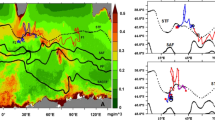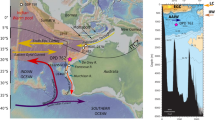Abstract
Helium isotopes in the ocean are very useful tracers of hydrothermal input and deep-sea circulation. Unlike labile trace elements, noble gases are inert and do not react with other substances in the water column. Previous studies in the Indian Ocean showed that helium isotopes in the region were discharged mainly from the central Indian midocean ridge, convergent boundaries, and the Pacific Ocean via currents that flow through the Indonesian archipelago. These Indonesian waters then exit out as the Indonesian Throughflow (ITF) into the Indian Ocean through shallow sills. The ITF plays a significant role in global climate, because it serves as the main pathway of thermocline waters between the Pacific Ocean and Indian Ocean. We present new helium isotope data from International Indian Ocean Expedition (IIOE-2) at the east Indian Ocean in December 2018. Helium isotopes were measured using a Noble Gas Mass Spectrometer at the Atmosphere and Ocean Research Institute, The University of Tokyo. We compare our data with those from previous expeditions and discuss the source and distribution of helium isotopes near Java. Waters with high excess 3He from the ITF were observed at 1000 m. Application of two-components mixing model enabled us to estimate ITF fraction in the observed area and to clarify the ITF flow in the deep layer. Moreover, flow rate of the deep ITF from Savu sill to Indian Ocean was estimated to be ~ 0.8–1.6 Sv. Based on stations near the Java coast, there could be a deep current or hydrothermal source at 3000 m that advects water enriched in 3He southwards along the Java Island.






Similar content being viewed by others
References
Belviso S, Jean-Baptiste P, Nguyen B, Merlivat L, Labeyrie L (1987) Deep methane maxima and 3He anomalies across the Pacific entrance to the Celebes Basin. Geochim Cosmochim Acta 51:2673–2680. https://doi.org/10.1016/0016-7037(87)90148-7
Boyer T, Baranova K, Coleman C, Garcia H, Grodsky A, Locarnini R, Mishonov A, O’Brien T, Paver C, Reagan J, Seidov D, Smolyar I, Weathers K, Zweng M (2018) World Ocean Database 2018. https://www.nodc.noaa.gov/OC5/SELECT/dbsearch/dbsearch.html
Chester R (1990) Dissolved gases in seawater. In: Marine geochemistry. Springer Dordrecht, Dordrecht. https://doi.org/10.1007/978-94-010-9488-7_8
Chinni V, Singh S, Bhushan R, Renjarahan R, Sarma V (2019) Spatial variability in dissolved iron concentrations in the marginal and open waters of the Indian Ocean. Mar Chem 208:11–28. https://doi.org/10.1016/j.marchem.2018.11.007
Clarke W, Beg M, Craig H (1969) Excess 3He in the sea: evidence for terrestrial primordial helium. Earth Planet Sci Lett 6:213–220. https://doi.org/10.1016/0012-821X(69)90093-4
Clarke W, Beg M, Craig H (1970) Excess helium 3 at the north pacific geosecs station. J Geophys Res 75:7676–7678. https://doi.org/10.1029/JC075i036p07676
Craig H, Clarke W, Beg M (1975) Excess 3He in the deep water of the East Pacific Rise. Earth Planet Sci Lett 26:125–132. https://doi.org/10.1016/0012-821X(75)90079-5
Fieux M, Andrie C, Delecluse P, Ilahude A, Kartavsteff A, Mantisi F, Molcard R, Swallow J (1994) Measurements within the Pacific-Indian Oceans throughflow region. Deep-Sea Res 41:1091–1130. https://doi.org/10.1016/0967-0637(94)90020-5
Fitzsimmons J, Boyle E, Jenkins W (2014) Distal transport of dissolved hydrothermal iron in the deep South Pacific Ocean. Proc Natl Acad Sci USA 111:16654–16661. https://doi.org/10.1073/pnas.1418778111
Gordon A (1986) Interocean exchange of thermocline water. J Geophys Res 91:5037–5046. https://doi.org/10.1029/JC091iC04p05037
Gordon A (2005) Oceanography of the Indonesian seas and their throughflow. Oceanography 18:14–27. https://doi.org/10.5670/oceanog.2005.01
Gordon A, Fine R (1996) Pathways of water between the Pacific and Indian oceans in the Indonesian seas. Nature 379:146–149. https://doi.org/10.1038/379146a0
Gordon A, Giulivi C, Ilahude A (2003) Deep topographic barriers within the Indonesian seas. Deep-Sea Res II 50:2205–2228. https://doi.org/10.1016/S0967-0645(03)00053-5
Gordon A, Sprintall J, Van Aken H, Susanto D, Wijffels S, Molcard R, Ffield A, Pranowo W, Wirasantosa S (2010) The Indonesian throughflow during 2004–2006 as observed by the INSTANT Program. Dyn Atmos Oceans 50:115–128. https://doi.org/10.1016/j.dynatmoce.2009.12.002
Hilton D, Craig H (1989) A helium isotope transect along the Indonesian archipelago. Nature 342:906–908. https://doi.org/10.1038/342906a0
Jean-Baptiste P, Fieux M, Ilahude A (1997) An eastern Indian ocean 3He section from Australia to Bali: evidence for a deep Pacific-Indian throughflow. Geophys Res Lett 24:2577–2580. https://doi.org/10.1029/97GL02071
Jenkins WJ, Edmond JM, Corliss JB (1978) Excess 3He and 4He in Galapagos submarine hydrothermal waters. Nature 272:156–158. https://doi.org/10.1038/272156a0
Jenkins W, Smethie W, Boyle E, Cutter G (2015) Water mass analysis for U.S. GEOTRACES (GA03) North Atlantic sections. Deep Sea Res Part II Top Stud Oceanogr 116:6–120. https://doi.org/10.1020/j.dsr2.2014.11.018
Lupton J (1983) Terrestrial inert gases: isotope tracer studies and clues to primordial components in the mantle. Annu Rev Earth Planet Sci 11:371–414. https://doi.org/10.1146/annurev.ea.11.050183.002103
Lupton J, Craig H (1981) A major 3He source at 15°S on the East Pacific Rise. Science 214:13–18
Ostlund G, Broecker W, Craig H, Spencer D (1987) GEOSECS Atlantic, Pacific and Indian Ocean Expedition, vol 7, Shore-based Data and Graphics, 199 plus xivpp., National Science Foundation, Washington, D.C
Reid J (2003) On the total geostrophic circulation of the Indian Ocean: flow patterns, tracers, and transports. Prog Oceanogr 56:137–186. https://doi.org/10.1016/S0079-6611(02)00141-6
Sano Y, Wakita H (1988) Precise measurement of helium isotopes in terrestrial gases. Bull Chem Soc Jpn 61:1153–1157. https://doi.org/10.1246/bcsj.61.1153
Sano Y, Tokutake T, Takahata N (2008) Accurate measurement of atmospheric helium isotopes. Anal Sci 24:521–525. https://doi.org/10.2116/analsci.24.521
Schlitzer R (2020) Ocean Data View. odv.awi.de
Sprintall J, Wijffels S, Chereskin T, Bray N (2002) The JADE and WOCE I10/IR6 Throughflow sections in the southeast Indian Ocean. Part 2: velocity and transports. Deep-Sea Res II 49:1363–1389. https://doi.org/10.1016/S0967-0645(01)00163-1
Sprintall J, Gordon A, Wijffels S, Feng M, Hu S, Koch-Larrouy A, Phillips H, Nugroho D, Napitu A, Pujiana K, Susanto R, Sloyan B, Pena-Molino B, Yuan D, Riama N, Siswanto S, Kuswardani A, Arifin Z, Wahyudi A, Zhou H, Nagai T, Ansong J, Bourdalle-Badie R, Chanut J, Lyard F, Arbic B, Ramdhani A, Setiawan A (2019) Detecting change in the Indonesian Seas. Front Mar Sci 6:257. https://doi.org/10.3389/fmars.2019.00257
Srinavasan A, Top Z, Schlosser P, Hohmann R, Iskandarani M, Olson D, Lupton J, Jenkins W (2004) Mantle 3He distribution and deep circulation in the Indian Ocean. J Geophys Res 109:C06012. https://doi.org/10.1029/2003JC002028
Takahata N, Shirai K, Ohmori K, Obata H, Gamo T, Sano Y (2018) Distribution of helium-3 plumes and deep-sea circulation in the central Indian Ocean. Terr Atmos Ocean Sci 29:331–340. https://doi.org/10.3319/TAO.2017.10.21.02
Talley L, Baringer M (1997) Preliminary results from WOCE hydrographic sections at 80°E and 32°S in the central Indian Ocean. Geophys Res Lett 24:2789–2792. https://doi.org/10.1029/97GL02657
Talley L, Sprintall J (2005) Deep expression of the Indonesian Throughflow: Indonesian Intermediate Water in the South Equatorial Current. J Geophys Res 110:C10009. https://doi.org/10.1029/2004JC002826
Top Z, Gordon A, Jean-Baptiste P, Fieux M, Ilahude G, Muchtar M (1997) 3He in Indonesian seas: inferences on deep pathways. Geophys Res Lett 24:547–550
Worthington L (1981) The water masses of the world ocean: some results of a fine-scale census. In: Warren BA, Wunsch C (eds) Evolution of physical oceanography, scientific surveys in honor of Henry Stommel. MIT Press, Cambridge, pp 42–69
Wyrtki K (1961) Scientific results of marine investigations of the South China Sea and the Gulf of Thailand, 1959–1961. NAGA Report 2, UC Scripps Institution of Oceanography, La Jolla, California
Xie T, Newton R, Schlosser P, Du C, Dai M (2019) Long-term mean mass, heat and nutrient flux through the Indonesian Seas, based on tritium inventory in the Pacific and Indian Oceans. J Geophys Res Oceans 124:3859–3875. https://doi.org/10.1029/2018JC014863
Acknowledgements
We thank Prof. Yukio Masumoto as the principal investigator, and the scientists and crew of R/V Hakuho Maru during the KH-18-6 Leg 3 cruise for their invaluable help during sample collection and CTD observation. Special thanks to Idha Yulia Ikhsani for assisting in collecting the samples for helium analysis. This study was supported by the JSPS Bilateral Joint Research Projects (JPJSBP120198201) to HO, a Grant-in-Aid for Scientific Research (A) (JP16H02701) to HO, and Grant-in-Aid for Scientific Research in Innovative Areas (JP15H05820) from the Ministry of Education, Culture, Sports, Science and Technology to HO.
Author information
Authors and Affiliations
Corresponding author
Electronic supplementary material
Below is the link to the electronic supplementary material.
Rights and permissions
About this article
Cite this article
Escobar, M.T., Takahata, N., Obata, H. et al. Observation of the deep Indonesian throughflow using helium isotopes. J Oceanogr 77, 93–101 (2021). https://doi.org/10.1007/s10872-020-00560-8
Received:
Revised:
Accepted:
Published:
Issue Date:
DOI: https://doi.org/10.1007/s10872-020-00560-8




